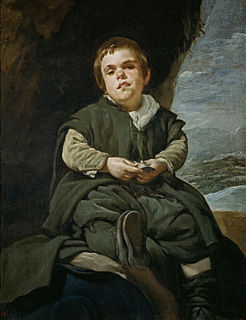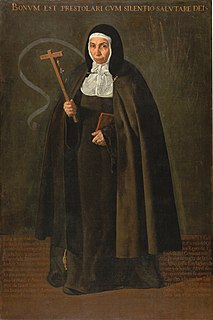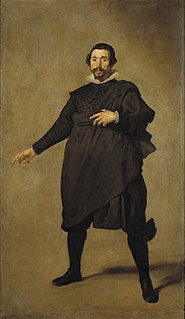 W
WThe Equestrian Portrait of Prince Balthasar Charles is a portrait of Balthasar Charles, Prince of Asturias on horseback, painted in 1634–35 by Diego Velázquez. It is now in the Prado.
 W
WPrince Balthasar Charles as a Hunter is a 1635 portrait of Balthasar Charles, Prince of Asturias by Diego Velázquez. It is now held at the Museo del Prado.
 W
WPortrait of the Infante Don Carlos is a 1626/27 oil painting of Don Carlos of Spain, produced by Diego Velázquez as one of the first paintings he produced during his stay in Madrid. It is now in the Prado.
 W
WDoña Antonia de Ipeñarrieta y Galdós and Her Son Don Luis is a 1634 portrait by Diego Velázquez, now in the Prado Museum. Doña Antonia and her son Luis are shown standing, captured in an elegant melancholy. The woman uses the chair to support herself, to emphasize her social status in the Court, where she had the right to sit. According to different studies of the canvas, it is believed that the child's figure could have been added afterwards.
 W
WThe portrait Equestrian Portrait of Elisabeth of France was painted by Velázquez of Elisabeth of France circa 1635, originally for the Hall of Realms, originally a wing of the Buen Retiro Palace in Madrid. It has been in the Prado since the gallery's institution in 1819.
 W
WThe Jester Barbarroja is an oil on canvas portrait by Diego Velázquez of Cristóbal de Castañeda y Pernia, nicknamed Barbarroja in his role as a jester at the court of Philip IV of Spain from 1633 to 1649. The painting is now in the Museo del Prado. It was in the Palacio del Buen Retiro in Madrid in 1701 and from 1816 to 1827 it was in the Real Academia de Bellas Artes de San Fernando.
 W
WThe Jester Calabacillas is a portrait by Velázquez of Don Juan Martín Martín, "Juan de Calabazas" or "El Búfón Calabacillas", a jester at the court of Philip IV of Spain, sometimes known by the nickname Bizco. It is now in the Prado Museum. The jester had mental illness(s), and would often rub his hands together in a form of tic; however, Velazquez painted him in a relatively calm state, further showing Velazquez's equal show of dignity to all, whether king or jester.
 W
WThe Jester Don Diego de Acedo is one of a series of portraits of jesters at the court of Philip IV of Spain by Diego Velázquez. Its subject is the dwarf Don Diego de Acedo, known as "el Primo". The 1645 oil painting is now in the Prado Museum. The work measures 106 cm high and 83 cm wide.
 W
WThe Jester Named Don John of Austria is a portrait by Velázquez, now in the Museo del Prado in Madrid. Its subject was a jester or bufón at the court of Philip IV of Spain from 1624 to 1654 who appeared in court comedies in front of important court figures. The subject's real name is unknown, but he came to be nicknamed after John of Austria, the son of Charles V, well known for his victory at Lepanto. He is shown dressed in a general's cloak and black doublet, is surrounded by abandoned helmets, armour and weapons, and with a fragment of a battle-scene of Lepanto in the background.
 W
WPortrait of Francisco Lezcano or The "Niño de Vallecas" is the 1645 portrait by Diego Velázquez of Francisco Lezcano, also known as Lezcanillo or el Vizcaíno, a jester at the court of Philip IV of Spain. It has been in the Prado since 1819.
 W
WInfanta Margarita Teresa in a Pink Dress is a 1660 oil on canvas portrait of Margaret Theresa of Spain by the Spanish painter Diego Velázquez, though his identification as its author is not considered secure. It is now in the Prado Museum in Madrid.
 W
WThe Equestrian Portrait of Margarita of Austria is a 1634 portrait of Margaret of Austria, Queen of Spain on horseback by Velázquez, originally shown at the Hall of Realms of the Buen Retiro Palace in Madrid and now in the Prado Museum.
 W
WThe Portrait of Maria Anna is a 1630 portrait of Maria Anna of Spain by Diego Velázquez. It is now in the Prado.
 W
WLas Meninas is a 1656 painting in the Museo del Prado in Madrid, by Diego Velázquez, the leading artist of the Spanish Golden Age. Its complex and enigmatic composition raises questions about reality and illusion, and creates an uncertain relationship between the viewer and the figures depicted. Because of these complexities, Las Meninas has been one of the most widely analyzed works in Western painting.
 W
WThe Portrait of Juan Martínez Montañés is an unfinished 1636 portrait of the sculptor Juan Martínez Montañés by Diego Velázquez. It is now in the collection of the Prado museum in Madrid.
 W
WThe Nun Jerónima de la Fuente is a full-length portrait painting by Diego Velázquez depicting the titular nun. Velázquez painted Jerónima, which is in oil on canvas, in 1620. It is now on display at the Museo del Prado in Madrid, Spain.
 W
WPortrait of Pablo de Valladolid is a portrait painted around 1635 by Diego Velázquez of Pablo or "Pablillos" de Valladolid (1587–1648), a jester and actor at Philip IV's court from 1632 until his death. It is now in the Museo del Prado, to which it was moved in 1827.
 W
WThe Equestrian Portrait of Philip III is a portrait of Philip III of Spain on horseback by Diego Velázquez. It was painted in 1634/35, some years after the subject's death, as part of a series of paintings of the royal family. Intended to be displayed in the Hall of Realms, originally a wing of the Buen Retiro Palace in Madrid, it is now in the Prado Museum.
 W
WThe Equestrian Portrait of Philip IV was a portrait of Philip IV of Spain on horseback, painted by Diego Velázquez in 1635-36 as part of a series of equestrian portraits for the Hall of Realms, originally a wing of the Buen Retiro Palace in Madrid.
 W
WThe Portrait of Philip IV in Armour is a portrait of Philip IV of Spain by Velázquez now in the Museo del Prado in Madrid. It is one of the artist's most realistic portraits of Philip IV and was one of the first he produced after being made painter to the king in 1623. Its style corresponds to the artist's beginnings in Seville and shows its subject in a sculptural style like a portrait bust, with abrupt colour contrasts.
 W
WPortrait of Mariana of Austria is a 1652–1653 oil-on-canvas painting by Diego Velázquez, the leading artist of the Spanish Golden Age, existing in a number of versions. Its subject, Doña Mariana, was the daughter of Emperor Ferdinand III and Maria Anna of Spain. She was nineteen years old when the painting was completed. Although described as vivacious and fun-loving in life, she is given an unhappy expression in Velázquez's portrait. The portrait is painted in shades of black and red, and her face is heavily made up. Her right hand rests on the back of a chair, and she holds a lace handkerchief in her left hand. Her bodice is decorated with jewellery, including a gold necklace, bracelets and a large gold brooch. A clock rests on scarlet drapery behind her, signifying her status and discernment.
 W
WThe Portrait of Sebastián de Morra is a painting by Diego Velázquez of Sebastian de Morra, a court dwarf and jester at the court of Philip IV of Spain. It was painted around 1644 and is now in the Prado in Madrid. Not much is documented about De Morra's life, other than the fact that he was brought to Spain by Phillip IV in 1643 and served the court for three years before his death in 1649. It wasn't until Velázquez became a court painter that he showed dwarfs with a warmer and naturalistic style compared to previous paintings. De Morra looks directly at the viewer, motionless, making no hand gestures, leading one critic to suggest that the painting represents a denunciation of the court's treatment of de Morra and other dwarfs. However, recently discovered inventories and previous documents relating to De Morra reveal that it could be known by a different name, El Primo.